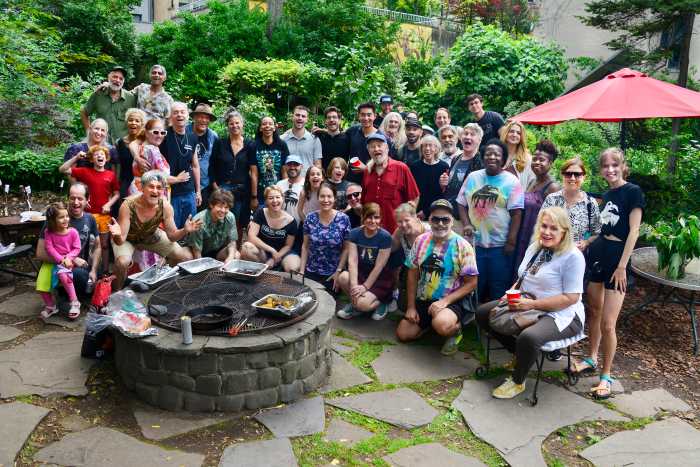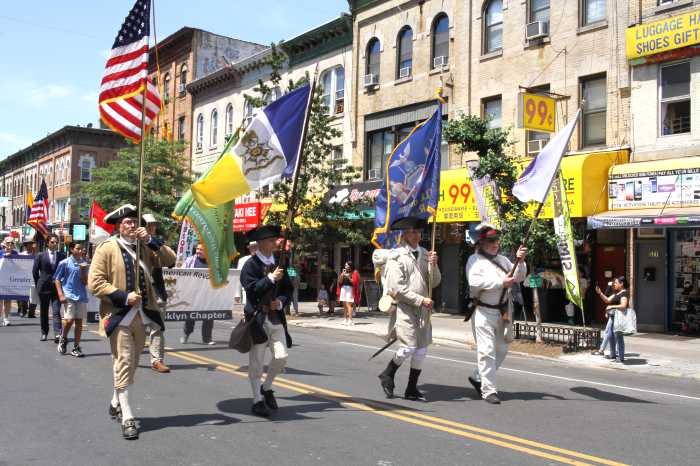By Albert Amateau
What New York University intended as a small East Village information meeting about its long-range development plans turned into an angry protest last Thursday about fears the university would not renew the lease of a Met Foodmarket on Second Ave.
More than 60 East Village neighbors, a couple of them in wheelchairs, turned up at a room with 30 seats on March 27 and made it clear they cared less about plans for 2031 than they did about the supermarket that Mike Schumacher and his brother Steve have been operating for more than 20 years on the ground floor of the N.Y.U. building at 107 Second Ave.
Waving placards saying, “I shop at the Met supermarket,” neighbors said they depended on Met Food for reasonable prices and a store within walking — or wheelchair — distance from their homes.
Mike Schumacher recalled N.Y.U.’s latest offer in lease negotiations that began more than a month ago.
“They [N.Y.U.] want to triple my rent on a three-year lease,” he said. “No supermarket can pay that kind of rent.”
Gary Parker, N.Y.U. director of government and community relations, who conducted the meeting, said he was taken by surprise regarding both the number of people who attended and the supermarket focus of discussion.
Parker said he was not prepared to speak about the Met Food issue and protested against getting neighbors publicly involved in a lease negotiation.
“We thought we were having fruitful discussions with Met Food and we’re disconcerted that they’re bringing community groups into the discussion,” he said.
Nevertheless, Parker said the university intends to keep a supermarket in the building no matter who eventually leases the space. Moreover, N.Y.U. would help the Schumachers find a new location if necessary, Parker said.
Neighbors, however, said Schumacher did not bring them to the meeting, but that the prospect of losing Met Food impelled them to attend.
“Met Food is a linchpin of our community,” said one neighbor. “They serve people in rent-stabilized housing. They serve your students. They help keep us a diverse community.”
Mike Schumacher said later that he didn’t want to do business anywhere else.
“These are my customers, my community — I serve a lot of N.Y.U. students,” he said. “When my brother and I started in 1986, N.Y.U. couldn’t find anyone to rent the place. The dean of the school at the time told me to hang in, things would get better.”
Schumacher noted that when negotiation on a new lease started, he still had a five-year renewal option, but N.Y.U. offered him only a one-year renewal at double the rent. He eventually rejected the offer and the university came back with a three-year lease at triple the rent.
Parker said that both N.Y.U. offers were below market rate. But Schumacher said, “Market rate for supermarkets is not the market rate for bars or restaurants.” Supermarkets he noted, require at least 10,000 square feet and could not do business at the square-foot rate that other retailers would pay.
But Alicia Hurley, N.Y.U. vice president for government and community relations, said later that the Schumachers have not come back to them with a counteroffer or even their own version of market rate.
“What they’re doing is getting public opinion to keep their profit margin as high as possible,” Hurley said. She added that she hopes to resolve the issue, being “fair” to Met Food and N.Y.U. and keeping with the university’s planning principles.
“Are you a real estate company or a university?” Charles Fitzgerald, a St. Mark’s Pl. resident, asked. “If you’re a university, you should be held to a higher standard.”
Another neighbor, David Mallius, said, “Talking about market rate, in this neighborhood market rate is determined by N.Y.U.” He noted how high-rise dorms change the character of a neighborhood and how hordes of students provide the market for bars that are overwhelming the neighborhood.
“Wouldn’t it have been wonderful if you had come here to say, ‘We have reached an agreement with Met Food?’ ” asked Bob Joyce, president of the E. Seventh St. Block Association. Later, Joyce said the N.Y.U. hard line regarding Met Food appears to contradict the university planning principles endorsed last year by Manhattan Borough President Scott Stringer, other elected officials and several civic groups.
One of the principles commits the university to “Support community sustainability by preserving existing diverse social and economic character by supporting community efforts to sustain affordable housing and local retail and exploring the use of ground floors for community-oriented uses such as local retail, gallery spaces, nonprofit uses and other providers of community services.”
Martha Danziger, former district manager of Community Board 3, said she had doubts about N.Y.U.’s promise that a supermarket would be in the building in which the Tisch School of the Arts is a dominant presence. In addition to being a source of reasonably priced groceries, Met Food contributes to public safety by lighting up the street late at night, Danziger said.
Another neighbor commented on the promise that a supermarket would be there even if Met Food didn’t get the lease:
“Who are you going to lease it to? Whole Foods? I don’t have the money to shop at Whole Foods.”
Anna Sawaryn of the Coalition to Save the East Village said she had advised N.Y.U. that the supermarket issue was on peoples’ minds and had urged the university to prepare for a large audience.





































